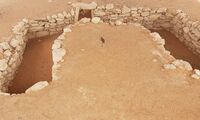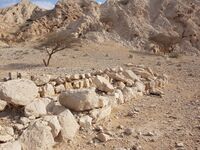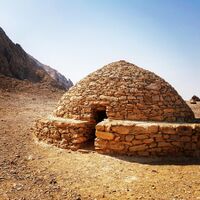Social:List of Ancient Settlements in the UAE
The territory currently known as the United Arab Emirates was formerly populated by inhabitants of a number of coastal and inland settlements, with human remains pointing to a pattern of transmigration and settlement as far back as 125,000 years.[1] Prehistoric settlement in the UAE took place in the Neolithic, with a number of distinctive eras of ancient settlement including the Stone Age Arabian Bifacial and Ubaid cultures from 5000 to 3100 BCE; the Hafit period with its distinctive beehive shaped tombs and Jemdet Nasr pottery, from 3200 to 2600 BCE; the Umm Al-Nar period from 2600 to 2000 BCE; the Wadi Suq Culture from 2000–1300 BCE and the three Iron Ages of the UAE.
Iron Age I spanned 1200–1000 BCE; Iron Age II from 1000–600 BCE and Iron Age III from 600–300 BCE. This was followed by the Hellenistic Mleiha era, from 300 BCE onwards through to the Islamic era which commenced with the culmination of the 7th century Ridda Wars.
The remains of settlements, burials and other extensive evidence of human habitation throughout these eras is littered throughout the UAE, with many extensive finds of rich materials in the shape of pottery, jewellery, weapons and both human and animal remains providing archaeologists and researchers with an increasingly sophisticated picture of longstanding involvement in regional trade alongside nomadic cultures eking out a living from the frequently arid and inhospitable desert and mountain environment of the UAE.
Settlements
| Settlement | Emirate (modern) | Populated | Notes |
|---|---|---|---|
| Al-Ashoosh | Dubai | 2500–2000 BCE | Umm Al Nar site with no burial discovered. |
| Al Madam | Sharjah | 1100–300 BCE | Iron age aflaj (water systems) |
| Al Sufouh | Dubai | 2500–2000 BCE | Umm Al Nar site with tomb |
| Bidaa bint Saud | Abu Dhabi | 3200–2600 BCE | Hafit and Iron age burials |
| Bithnah | Fujairah | 2000–300 BCE | Wadi Suq burials and iron age petroglyphs |
| Ed-Dur | Umm Al Quwain | 5300 BCE–300 CE | Major ancient city/settlement spanning Ubeid period through Umm Al Nar, Wadi Suq to Iron Age |
| Hili | Abu Dhabi | 3200–2600 BCE | Hafit and Umm Al Nar tombs |
| Jebel Buhais | Sharjah | 5000–1300 BCE | Necropolis featuring Stone, Bronze, Iron and Hellenistic age burials |
| Jebel Faya | Sharjah | 125,000 BCE | Neolithic, Paleolithic, Stone, Bronze age finds (See Mleiha) |
| Jebel Hafeet | Abu Dhabi | 3200-2600 BC | Gave its name to the Hafit period, extensive beehive tombs, with some reconstructed |
| Jumayra | Dubai | Connected to the historical region of Tawam.[2][3] | |
| Kalba | Sharjah | 2500–1300 BCE | Umm Al Nar settlement |
| Masafi | Ras Al Khaimah | 1300–300 BCE | Iron age finds |
| Mleiha | Sharjah | 5300–300 BCE | Settlement through Ubaid, Hafit, Umm Al Nar, Wadi Suq and Iron Age to Hellenistic Mleiha period. |
| Muweilah | Sharjah | 1100–600 BCE | Iron Age II settlement |
| Qattara Oasis | Abu Dhabi | 1800–1500 BCE | Bronze and Iron age settlement |
| Rumailah | Abu Dhabi | 2000–1000 BCE | Umm Al Nar through to Iron Age II settlement |
| Saruq Al Hadid | Dubai | 2600 BCE–1000 CE | Occupation since Umm Al Nar period, major Iron Age metallurgical centre |
| Seih Al Harf | Ras Al Khaimah | 2000–1300 BCE | Extensive Wadi Suq burial site |
| Shimal | Ras Al Khaimah | 2500–1300 BCE | Umm Al Nar/Wadi Suq burials |
| Tell Abraq | Umm Al Quwain/Sharjah | 2500–400 BCE | Major settlement, spanning Umm Al Nar, Wadi Suq and Iron Age |
| Thuqeibah | Sharjah | 1100–400 BCE | Iron age II and III settlement |
| Umm Al-Nar | Abu Dhabi | 2600–2000 BCE | Burials and settlement defined the Umm Al Nar period |
See also
- List of cultural property of national significance in the United Arab Emirates
- List of cities of the ancient Near East
References
- ↑ "New timeline for first early human exodus out of Africa | EarthSky.org" (in en-US). http://earthsky.org/human-world/new-timeline-for-first-early-human-exodus-out-of-africa.
- ↑ Abed, Ibrahim; Hellyer, Peter (2001). "The Coming of Islam and the Islamic Period in the UAE". The United Arab Emirates, A New Perspective. London: Trident Press Ltd.. pp. 73–88. ISBN 978-1-900724-47-0. https://books.google.com/books?id=QcMz3zV0qAMC&q=jumayra#v=snippet&q=jumeirah&f=false.
- ↑ Leech, Nick (2015-10-22). "The long read: has a lost Arab capital been found on the Oman-UAE border?". The National. https://www.thenational.ae/arts-culture/the-long-read-has-a-lost-arab-capital-been-found-on-the-oman-uae-border-1.4941.
Template:United Arab Emirates topics
 |





